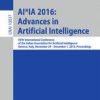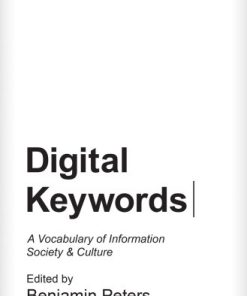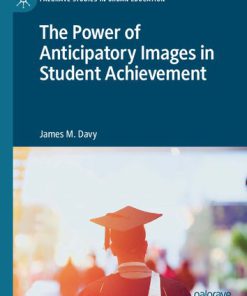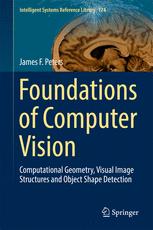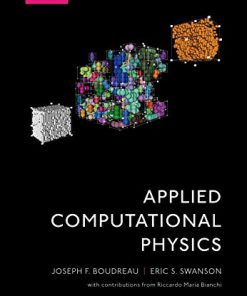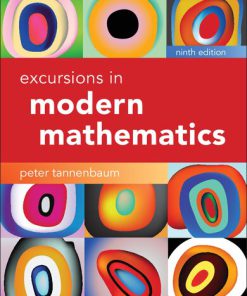Computational Proximity Excursions in the Topology of Digital Images 1st edition by James Peters 3319302604 9783319302607
$50.00 Original price was: $50.00.$25.00Current price is: $25.00.
Computational Proximity Excursions in the Topology of Digital Images 1st edition by James Peters – Ebook PDF Instant Download/Delivery:3319302604,9783319302607
Full download Computational Proximity Excursions in the Topology of Digital Images 1st edition after payment
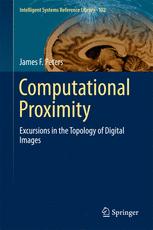
Product details:
ISBN 10:3319302604
ISBN 13:9783319302607
Author:James Peters
This book introduces computational proximity (CP) as an algorithmic approach to finding nonempty sets of points that are either close to each other or far apart. Typically in computational proximity, the book starts with some form of proximity space (topological space equipped with a proximity relation) that has an inherent geometry. In CP, two types of near sets are considered, namely, spatially near sets and descriptivelynear sets. It is shown that connectedness, boundedness, mesh nerves, convexity, shapes and shape theory are principal topics in the study of nearness and separation of physical aswell as abstract sets. CP has a hefty visual content. Applications of CP in computer vision, multimedia, brain activity, biology, social networks, and cosmology are included. The book has been derived from the lectures of the author in a graduate course on the topology of digital images taught over the past several years. Many of the students have provided important insights and valuable suggestions. The topics in this monograph introduce many forms of proximities with a computational flavour (especially, what has become known as the strong contact relation), many nuances of topological spaces, and point-free geometry.
Computational Proximity Excursions in the Topology of Digital Images 1st Table of contents:
1 Computational Proximity
1.1 Computational Proximity Framework
1.2 Points, Regions, Connectedness and Point-Free Geometry
1.3 Choice of Probe
1.4 Proximities
1.5 Di Concilio Strong Contact
1.6 Strongly Far Proximity
1.7 Convexity Structures
1.8 Descriptive Proximity
1.9 Descriptive Strong Proximity
1.10 Nerves
1.11 Voronoï Diagrams and Mesh Nerves
1.12 Origins, Variations and Applications of Voronoï Diagrams
1.13 Mesh Nerves on a Digital Image
1.14 Singer Needle Tip Image Mesh: A Step Toward Object Recognition
1.15 Topological Spaces: Setting for Computational Proximity
1.16 Connectedness and Strongly Near Connectedness
1.17 Connected and Strongly Connected Mesh Nerves
1.18 Boundedness, Bornology and Bornological Nerves
1.19 Proximal Boundedness, Strong Proximal Boundedness
1.20 Local Proximity Spaces and Local Strong Proximity Spaces
References
2 Proximities Revisited
2.1 Cech Proximity
2.2 Cech Closure of a Set
2.3 Near Edge Sets
2.4 Lodato Proximity
2.5 Descriptive Lodato Proximity
2.6 Delaunay Triangulation
2.7 Voronoï Diagrams Revisited
2.7.1 Sites
2.8 Some Results for Voronoï Regions
2.9 Dirichlet Tessellation Quality and Digital Image Quality
2.10 Tessellation Region Centroids
2.11 Centroid-Based Voronoï Mesh on an Image
References
3 Distance and Proximally Continuous
3.1 Metrics and Metric Topology
3.2 Distances: Euclidean and Taxicab Metrics
3.3 Metric Proximity
3.4 Closeness Metric
3.5 Some Recent History of Near Sets
3.6 Descriptive Similarity Distance
3.7 Descriptively Near Sets Can Be Spatially Disjoint Sets
3.8 Neighbourhoods of Points in Euclidean Space
3.9 2D Picture Descriptive Neighbourhood of a Point
3.9.1 Unbounded Descriptive Neighbourhood of a Picture Point
3.9.2 Bounded Descriptive Neighbourhood of a Picture Point
3.9.3 Bounded Indistinguishable Descriptive Neighbourhood of a Picture Point
3.9.4 Unbounded Indistinguishable Descriptive Neighbourhood of a Picture Point
References
4 Image Geometry and Nearness Expressions for Image and Scene Analysis
4.1 Image Geometry
4.1.1 Delaunay Triangulation
4.1.2 Voronoï Diagrams
4.2 Nearness Expressions: Basic Notions
4.3 Near and Strongly Near Sets Revisited
4.3.1 Lodato Proximity Revisited
4.3.2 Descriptive Lodato Proximity Revisited
4.3.3 Strong Proximity Revisited
4.3.4 Descriptive Strong Proximity Revisited
4.4 Di Concilio–Gerla Overlap Revisited
4.5 Wallman Proximity Revisited
4.6 Far and Strongly Far Sets Revisited
References
5 Homotopic Maps, Shapes and Borsuk–Ulam Theorem
5.1 Antipodal Points and Hyperspheres
5.2 Borsuk–Ulam Theorem
5.3 Homotopic Maps and Deformation Retracts
5.4 Object Description, Structured Sets and Shape Features
5.4.1 Euclidean Feature Space
5.4.2 Feature Vectors
5.5 Strongly Proximal Object and Feature Spaces
5.6 Strong Proximal Borsuk–Ulam Theorem
5.7 Strong Proximal Region-Based Borsuk–Ulam Theorem
5.8 Complexes, Nuclei and Applied Homotopy
5.9 Strong Proximal Homotopy
5.10 Borsuk–Ulam Theorem Extended to Hyperbolic Surfaces by A. Tozzi
References
6 Visibility, Hausdorffness, Algebra and Separation Spaces
6.1 Visibility
6.2 Separation Axioms
6.3 R0 Symmetric Space
6.4 Descriptive R0 Space
6.4.1 Near Sets in L-Proximity Spaces
6.4.2 Descriptive L-Proximity
6.4.3 Descriptive Proximity Space Revisited
6.5 T0 Anti-Symmetric Space
6.6 T1 Space
6.7 Hausdorff T2 Space
6.8 Hausdorffness and Visibility
6.9 Partial Descriptive Groupoids in Hausdorff Spaces
6.10 Set-Based Probes and Proximal Delaunay Groupoids
6.11 Voronoï Groupoids
6.12 T3 Space
6.13 T4 Space
6.14 Visual Set Patterns in Descriptive Separation Spaces
6.14.1 Visual Patterns in Descriptive T1 Spaces
6.14.2 Visual Patterns in Descriptive T2 Spaces
6.14.3 Set Pattern Generators
References
7 Strongly Near Sets and Overlapping Dirichlet Tessellation Regions
7.1 Known Mesh Seed or Generating Points
7.2 Julia Set Image Example
7.3 Strongly Near Regions and Mesh Cells
7.4 Back to Earth
References
8 Proximal Manifolds
8.1 Manifolds: Basic Notions
8.2 Charts and Atlases
8.3 Proximal Voronoï Manifolds, Atlases and Charts
8.4 Mean Shift Manifold
8.5 Digital Image Manifolds
8.6 Mean-Shift Image Manifolds
8.7 Image Saliency Manifolds
8.8 Selfie Voronoï Manifold
8.9 Manifolds with a Proximity
References
9 Watershed, Smirnov Measure, Fuzzy Proximity and Sorted Near Sets
9.1 See-Through MM Segments Via Dirichlet Tessellation on an Image
9.2 Strongly Near Voronoï Region Interiors on MM Segmentations
9.3 Extension of Smirnov Proximity Measure
9.4 Fuzzy Lodato Proximity and Fuzzy Lodato–Smirnov Membership Function
9.5 Descriptive Smirnov Proximity
9.6 Application: Sorting Near Sets Using Smirnov Proximity Measures
9.7 Fuzzy Descriptive Lodato Proximity Space
9.8 Image Dilation
9.9 MorphologicalBinarize Operation with Lower and Upper Bounds
9.10 Dilation Method
9.11 Dilation and Watershed Segmentation
9.12 Gradient Filtering Watershed Components
References
10 Strong Connectedness Revisited
10.1 Connectedness: Basic Concepts
10.2 Strongly Connected Subsets in a Voronoï Mesh
References
11 Helly’s Theorem and Strongly Proximal Helly Theorem
11.1 Helly’s Theorem
11.2 Strongly Near Version of Helly’s Theorem
11.3 Descriptive Helly’s Theorem
11.4 Polyforms
References
12 Nerves and Strongly Near Nerves
12.1 Polyform Nerves
References
13 Connnectedness Patterns
13.1 Connectedness in Voronoï Meshes
13.2 Nearness of Collections of Strongly Connected Sets
13.3 Picture Mesh Patterns
13.4 Pattern Axioms and Object Signature Axioms
13.5 Keypoints Mesh Sites
13.6 Keypoints Mesh Patterns
References
14 Nerve Patterns
14.1 Voronoï Mesh Nerves
14.2 Nerves with a Nucleus
14.3 Partial Ordering of Nuclei
14.4 Voronoï Mesh Nerve Patterns
People also search for Computational Proximity Excursions in the Topology of Digital Images 1st:
exploring computing
computational probability and inference
introduction to topological quantum computation
knowledge complexity of interactive proof systems
extracting insights from the shape of complex data using topology
Tags:
James Peters,Proximity,Computational,Excursions,Topology
You may also like…
Uncategorized
Arts - Architecture
dictionaries & phrasebooks
Digital keywords a vocabulary of information society and culture Peters
Education Studies & Teaching - School Education & Teaching
Politics & Philosophy
The Power of Anticipatory Images in Student Achievement 1st Edition James M. Davy
Computers - Computer Science
Education Studies & Teaching - School Education & Teaching
Excursions in Modern Mathematics 9th Edition Peter Tannenbaum



